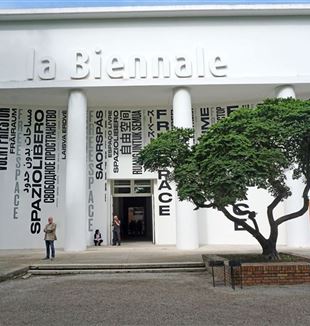
Venice: Francis’ 'attempt' at the Biennale
'Making peace' and reconciling with the contemporary art world. A path that the Holy See took more than fifty years ago with Paul VI, and which will take Pope Francis to the Lagoon on April 26.The Venice Biennale is probably the most important event in the world of contemporary art. Artists, critics, gallery owners, museum and foundation directors, sector journalists: everyone stops and looks at what is happening in the city of Saint Mark, as happens for cinema and music with Oscars or the Grammys. Those who exhibit in Venice are in the spotlight. It is not just about visibility or success, the Biennale is a kind of seismograph of contemporaneity. Those who visit the main exhibition and the national pavilions do so because, deep down, they want to understand how artists interpret and experience the present. The Pope is no exception. His visit to the Lagoon on April 28 will above all be a sign of curiosity, but also of his desire to be present where things happen, moving towards people, without waiting for people to come to him. It is a visit that is, in itself, the manifesto of a cultural position.
Francis will travel to the Serenissima city and will take part in the event; he will be the first Pope in history to do so, visiting the pavilion of the Holy See, which will be set up in the women's prison on the Giudecca. The pavilion promoted by Cardinal José Tolentino de Mendonça, Prefect of the Dicastery for Culture and Education, is one of the 88 national participations that will coexist with the great main exhibition by Brazilian curator Adriano Pedrosa, entitled "Stranieri Ovunque - Foreigners Everywhere", which will be held, as happens every two years, in the spaces of the Gardens of the Biennale and in those of the Corderie dell'Arsenale. The national participations are called upon to choose one or more artists who are considered to represent what is happening in the individual country.
The participation of the Holy See, as is evident, is anomalous: it carries the legacy of the greatest art patron in the history of mankind, but not a single artist lives within its territory. This is the fifth time the Vatican has been present at the Biennale. The first was in 2013, at the insistence of Cardinal Gianfranco Ravasi, then President of the Pontifical Council for Culture, then in 2015. In 2018 and 2023, however, the Vatican was represented at the Architecture Biennale. This year, Cardinal Tolentino has entrusted the pavilion to two leading curators: Chiara Parisi, director of the Centre Pompidou-Metz, and Bruno Racine, director of Palazzo Grassi - Punta della Dogana. The title of the exhibition will be 'With My Eyes' and, as already said, it will be set up in a symbolic place: the women's prison of the Giudecca. The prison is in fact housed in the buildings of an old convent, created to house 'converted' prostitutes who had become destitute. The artists announced are: Maurizio Cattelan (the world's best-known living Italian artist who likes to be controversial), Bintou Dembélé (dancer and choreographer, pioneer of hip hop dance), Simone Fattal (artist and writer born in Syria and raised in France), Claire Fontaine (art collective formed by James Thornhill and Fulvia Carnevale), Sonia Gomes (Brazilian artist, known for her work with textiles), Corita Kent (legendary Los Angeles artist nun who marked the season of Pop Art), Marco Perego & Zoe Saldana (he is an Italian director, she is Hollywood star), Claire Tabouret (French painter based in Los Angeles). As with the other participants at the Biennale, this will not be a 'liturgical art' exhibition. This is not the meaning of the Vatican’s participation in Venice. But it will be a new opportunity for dialogue, even before the public, with the artists.
Read also - Miguel Benasayag. The machine of the world
The initiative, in fact, is thought of as a stage in the long journey of the Church's rapprochement with the contemporary art world, which began with the unforgettable speech that Paul VI made to artists in 1964: "And therefore your language for our world was docile, yes, but almost bound, faltering, unable to find its free voice. And we have felt, then, the dissatisfaction of this artistic expression. And – we will perform a complete Confiteor this morning, at least here – we treated you even worse. We turned to surrogates, to “oleography”, to works of art of little worth and little value, even though, in our defence, we did not have the means to accomplish great things, beautiful things, new things, things worthy to be admired; and so even we were side-tracked down paths where art and beauty and – which is the worst for us – the worship of God were poorly served. Shall we make peace again? Today? Here? Do we want to be friends again?” It was a new beginning, which also continued with the successive Popes: John Paul II, Benedict XVI and, indeed, Francis. They all sought dialogue with the great artists. A dialogue that could not hark back to a glorious past, but be reborn in the present under the conditions of the present. Without rushing immediately, necessarily, to commission churches, palaces, new altarpieces, but to reactivate a relationship, at least of mutual esteem, hoping that it could become friendship between people.
Like any exhibition, the Holy See pavilion will have to be judged by going to see it, bearing in mind that it is an attempt within a journey. No one can know a priori what this journey will lead to. And rightly so. In the life of the Church we must be ready to welcome and contemplate God's surprises.